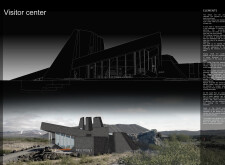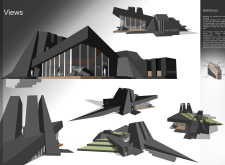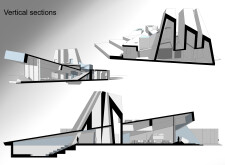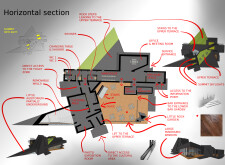5 key facts about this project
At the heart of the project’s concept is a desire to create a structure that feels as though it emerges naturally from the ground. The building comprises three distinct volumes that evoke the local boulders and rock formations, establishing a visual dialogue with the landscape. This design approach symbolizes a profound respect for nature, highlighting how human-made structures can coexist with their environments without dominating them.
The primary function of the Visitor Center is to facilitate a range of activities that enhance the visitor experience. It includes reception areas for orientation, exhibit spaces for showcasing local culture and geology, and multipurpose rooms that can host various events. The layout is organized to encourage movement and exploration, creating connections between different spaces while seamlessly guiding visitors through their journey.
The design thoughtfully incorporates various architectural elements that support its functionality. Large glass windows frame panoramic views of the landscape, allowing natural light to flood the interior and providing visual connectivity to the outside world. This choice reinforces the relationship between the interior spaces and the natural environment, allowing visitors to feel immersed in their surroundings regardless of whether they are indoors or outside.
Additionally, the use of ecological mortar and concrete cladding, made from locally sourced materials, exemplifies the project’s commitment to sustainability. These materials not only define the aesthetic quality of the structure but also contribute to its resilience against the regional climate. The selection and application of these elements reflect careful consideration of durability and maintenance, ensuring the building will serve its purpose for years to come.
The Visitor Center’s unique design approaches are particularly noteworthy. The project features dynamically organized spaces that cater to various visitor needs, such as an information desk, cultural exhibition areas, an auditorium, and service facilities. This thoughtful planning enables the center to function as a hub of community engagement, education, and relaxation, fostering a welcoming atmosphere for all visitors.
In addition to its functional aspects, the building’s architecture emphasizes experiential pathways, connecting different levels and areas in a fluid manner. This intricate spatial organization invites exploration, encouraging visitors to engage with the space in a natural and intuitive way. The combination of various heights and perspectives allows for a continued sense of discovery throughout the visit.
The Visitor Center is not merely a place to gather information; it stands as a testament to the potential of architectural design to foster connection between people and nature. Each design decision is anchored in principles that prioritize sustainability, local culture, and environmental awareness. By carefully addressing the relationship between architecture and its geographic context, the project sets a precedent for similarly ambitious designs in other locations.
To gain a deeper understanding of this architectural endeavor, including specific architectural plans, architectural sections, and additional architectural designs that illustrate these ideas effectively, viewers are encouraged to explore the project presentation further. Such insights will enrich appreciation for how this project fulfills its purpose while maintaining a strong connection to the surrounding landscape and community.


























